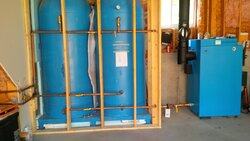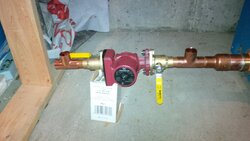Good evening all.
Newbie here. I purchased my boiler in May of 2013 thinking it would be no problem getting things going for last winter. Well here I am with my install still not finished. I am near Ottawa, Canada and figured there would be plenty of knowledgeable wood boiler fellows that I could hire to help me out but that dream ended as quickly as it came.
I discovered this site about a year ago and boy have I learned from you guys. The problem is that every time I think I have things covered, you throw something new at me. Lots of fun though. I especially like it when someone works through their entire install and posts it like Carprofessor has been doing recently. I see he even lives in my area.
I have to get this thing up and running for this winter or my 4 daughters and my wife are going to toss me out as a lost cause. I am hoping someone here is willing to help me out.
I grew up on the farm and have been using wood stoves all my life and this is the logical next step.
I live in an old farmhouse with about 1700 square feet to heat. I will be using some old cast iron rads that we have refurbished along with a small section of radiant floor in the basement of a small addition.
My boiler is in my detached garage. The garage has a finished loft above it which I also plan on heating with the boiler.
I have my Logstor 1" underground line already in and my storage tanks installed and plumbed. 1 1/4" copper from the boiler to the tanks then 1" to the house. Here is a picture of how they are set up. Ted Kestor, the same fellow that Carprofessor got his tanks from, also built mine. No I didn't have them painted the same color on purpose.

There will be air vents on the top of each tank.
I have a lot of questions but the part I need to finish first is the connection of the boiler to the tanks. The return line with the 15-58 pump that you can see is just dry fitted. I am using a Caleffi 280 series boiler protection valve which will be installed at the bottom of the bypass loop with the pump between it and the boiler.
The top supply line will have an air separator and a low water cut off. I will put a check valve on the supply line just before it reaches the tanks to prevent the tanks from thermosiphoning back.
The part I am stuck on is how to handle the "power off" situation and the overheat during a regular burn with power on. I would like to avoid having a gravity dump as it seems fruitless when I can just have a battery backup that will let my burn finish as usual. That will handle the power off situation but what about the overheat with power on? Should I be having a pump hooked up to my overtemp circuit on the boiler that pumps to some emitters in the finished room on the floor above? For normal usage I was hoping I could just cut a hole in the ceiling above the boiler and let the heat from the boiler room rise up.( I will eventually be continuing the wall on the front of the tanks across in front of the boiler to the far wall). This would save me the cost of the emitters for a room that is hardly ever used and has electric baseboards when more heat is needed. Why can't I just use my tanks to absorb an overheat? Is it possible to put tees on each side of my pump and build a bypass with another 15-58 pump in parallel that is set on high. It would be wired to the overtemp circuit so that it would come on in addition to the regular pump, hoping that this would move more water and take care of the situation? Feasible?
Sorry for being long winded but I wanted to give as much info as possible. I hope the picture worked.
Thanks a bunch.
Boardroom.
Newbie here. I purchased my boiler in May of 2013 thinking it would be no problem getting things going for last winter. Well here I am with my install still not finished. I am near Ottawa, Canada and figured there would be plenty of knowledgeable wood boiler fellows that I could hire to help me out but that dream ended as quickly as it came.
I discovered this site about a year ago and boy have I learned from you guys. The problem is that every time I think I have things covered, you throw something new at me. Lots of fun though. I especially like it when someone works through their entire install and posts it like Carprofessor has been doing recently. I see he even lives in my area.
I have to get this thing up and running for this winter or my 4 daughters and my wife are going to toss me out as a lost cause. I am hoping someone here is willing to help me out.
I grew up on the farm and have been using wood stoves all my life and this is the logical next step.
I live in an old farmhouse with about 1700 square feet to heat. I will be using some old cast iron rads that we have refurbished along with a small section of radiant floor in the basement of a small addition.
My boiler is in my detached garage. The garage has a finished loft above it which I also plan on heating with the boiler.
I have my Logstor 1" underground line already in and my storage tanks installed and plumbed. 1 1/4" copper from the boiler to the tanks then 1" to the house. Here is a picture of how they are set up. Ted Kestor, the same fellow that Carprofessor got his tanks from, also built mine. No I didn't have them painted the same color on purpose.

There will be air vents on the top of each tank.
I have a lot of questions but the part I need to finish first is the connection of the boiler to the tanks. The return line with the 15-58 pump that you can see is just dry fitted. I am using a Caleffi 280 series boiler protection valve which will be installed at the bottom of the bypass loop with the pump between it and the boiler.
The top supply line will have an air separator and a low water cut off. I will put a check valve on the supply line just before it reaches the tanks to prevent the tanks from thermosiphoning back.
The part I am stuck on is how to handle the "power off" situation and the overheat during a regular burn with power on. I would like to avoid having a gravity dump as it seems fruitless when I can just have a battery backup that will let my burn finish as usual. That will handle the power off situation but what about the overheat with power on? Should I be having a pump hooked up to my overtemp circuit on the boiler that pumps to some emitters in the finished room on the floor above? For normal usage I was hoping I could just cut a hole in the ceiling above the boiler and let the heat from the boiler room rise up.( I will eventually be continuing the wall on the front of the tanks across in front of the boiler to the far wall). This would save me the cost of the emitters for a room that is hardly ever used and has electric baseboards when more heat is needed. Why can't I just use my tanks to absorb an overheat? Is it possible to put tees on each side of my pump and build a bypass with another 15-58 pump in parallel that is set on high. It would be wired to the overtemp circuit so that it would come on in addition to the regular pump, hoping that this would move more water and take care of the situation? Feasible?
Sorry for being long winded but I wanted to give as much info as possible. I hope the picture worked.
Thanks a bunch.
Boardroom.


 .
.